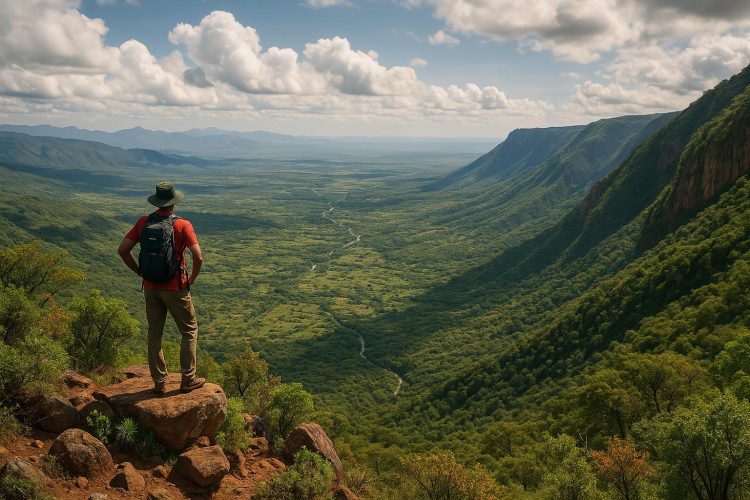Overview of Kerio Valley
The Kerio Valley is a significant geographical feature located within the expansive Rift Valley area in Kenya. It is an integral part of the renowned Great Rift Valley system, which is a standout element of Africa’s diverse physical geography. Extending over a length of approximately 80 kilometers, this valley is distinguished by its remarkable landscapes, which include majestic escarpments that help narrate a unique geological history. For individuals interested in gaining a deeper understanding of both the geographical and cultural elements of Kerio Valley, exploration of regional tourism resources or official travel advisories by the Kenyan government would be beneficial.
Geographical Location
Strategically positioned between the towering Tugen Hills and the impressive Elgeyo Escarpment, Kerio Valley delves to a dramatic depth of about 4,000 feet. This geographical marvel is traversed by the Kerio River, which plays a pivotal role in sustaining the valley’s rich biodiversity. The valley is most conveniently accessed through the town of Iten, a place globally recognized as a training hub for long-distance runners who excel on the world stage. The geographical setup not only provides a unique landscape to explore but also serves as a case study for understanding tectonic movements and climatic adaptations over centuries.
Climate and Environment
Kerio Valley is predominantly characterized by a semi-arid climate with distinct seasonal variations. It experiences two primary seasons: a wet period spanning March to May and a dry phase occurring from June to September. This particular climatic arrangement supports a remarkable variety of flora and fauna, thereby making the valley an alluring destination for ecologists and nature aficionados alike. The interplay between the wet and dry seasons creates an environment that fosters diverse biological adaptations, paving the way for species survival in a marginally harsh climatic setting.
Wildlife and Vegetation
Teeming with life, the valley hosts an array of wildlife species, including baboons, various species of antelopes, and a plethora of unique bird species. These animals thrive within a habitat enriched by an assortment of plant species, ranging from sturdy acacia trees to resilient thorny bushes. This rich biodiversity not only enhances the valley’s ecological value but also offers splendid opportunities for activities such as bird watching and landscape photography, which are major draws for eco-tourists. The interaction of wildlife with the dynamic landscape makes it a living laboratory for ecological and environmental studies.
Culture and People
The Kerio Valley region is predominantly inhabited by the Kalenjin community, among other ethnic groups. The Kalenjin people are celebrated for their vibrant cultural heritage, which continues to thrive in this distinctive geographical setting. As the primary economic activities, agriculture and livestock rearing form the backbone of the local economy. Visitors have the opportunity to immerse themselves in local culture through various means, including homestay programs and participation in traditional community events. To obtain more intimate knowledge of the local traditions and way of life, one might consider reaching out to community-based tourism initiatives, which offer authentic cultural experiences founded on mutual respect and understanding.
Tourist Attractions
Visitors to Kerio Valley can look forward to a rich itinerary featuring both natural and cultural attractions. Numerous viewpoints along the escarpment offer sweeping panoramic vistas of the valley below, providing ideal backdrops for photography and leisurely walks. The Rimoi National Reserve stands as a centerpiece for wildlife enthusiasts, presenting opportunities for exciting game drives and wildlife observation expeditions. Furthermore, the escarpments surrounding the valley are home to scenic hiking trails that offer not only physical challenges but also aesthetically pleasing views of the valley’s distinctive topography.
Travel Tips
For those planning to visit Kerio Valley, it is crucial to take into account several logistical considerations. Road conditions, while generally manageable, can become challenging, particularly during the rainy season, necessitating the use of a sturdy four-wheel-drive vehicle. Accommodation options in and around the valley range from modest lodges to comfortable guesthouses available in nearby towns, ensuring that visitors can find lodging consistent with their preferences. Prioritizing personal safety entails adhering to local guidelines, being conscious of environmental conditions, and being well-prepared for the rigors of travel in a semi-arid setting.
In addition to these practical tips, potential visitors should avail themselves of detailed travel planning resources. Official Kenyan tourism websites offer invaluable insights and up-to-date information on visiting Kerio Valley, including the best times to travel, anticipated weather conditions, and any other travel advisories pertaining to the region. By consulting these resources, travelers can ensure that their visit to this remarkable part of Kenya is both safe and enjoyable.
Thus, Kerio Valley stands as not just a geographical feature, but a vibrant tapestry of life, culture, and unparalleled beauty. This convergence of natural beauty and cultural richness underscores the valley’s significance as both a tourist destination and a focal point for ecological and cultural studies.
